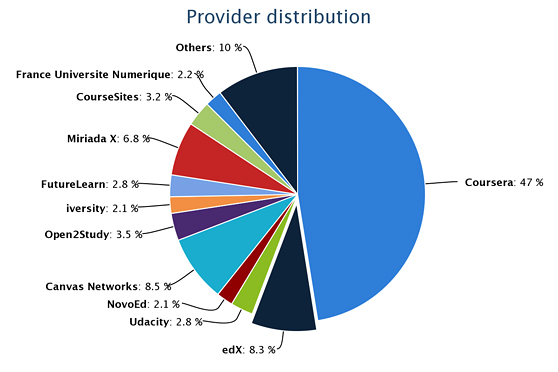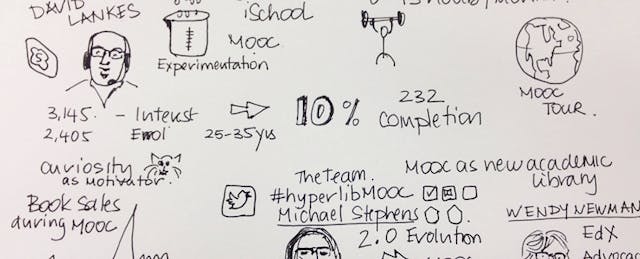In November 2011 I was taking one of the first MOOCs from Stanford. At that time, many new MOOCs were being announced and I started Class Central as a way to keep track of them and figure out what I should take next. The website gathers course listings through provider sites, social media, and tips from MOOC providers and users. The figures below are based on these data.
200+ universities. 1200+ courses. 1300+ instructors. 10 million students.
For the first time in history, courses that were limited to a small number of students are now open to the entire world--or at least those with access to the Internet. These courses are known as “MOOCs” (Massive Open Online Courses), a term that has now become a part of our everyday vocabulary. (It was recently added to the Oxford Dictionary.) Over the past two years, MOOCs have been embroiled in controversy with regards to their efficacy and role in relation to traditional in-person university classes. And it’s still not clear whether they have a sustainable business model.
However, while the debate rages on, teachers have been busy offering MOOCs and students have been signing up in droves–we estimate at least 10 million people have registered for MOOCs.
The number of courses offered has grown from about 100 MOOCs in 2012 to almost 700 starting in 2013, with an average of nearly two new MOOCs starting every day. More than 1200 courses have been announced so far.

Providers
Coursera remains the largest MOOC provider by far, with almost half of all the MOOCs offered. But its share is slowly being reduced by new MOOC providers from different parts of the world. Aside from Coursera, edX, and Udacity, other startups from outside the U.S. are gearing up to offer MOOCs. To mention a few, 2013 saw the launch of FutureLearn, Open2Study, iversity, and France Université Numerique.

Subjects
The first wave of MOOCs in 2011 were overwhelmingly concentrated in the Computer Science/Engineering category. But we are now seeing the emergence of courses that tackle a broad array of topics. Significantly, the Humanities (comprising numerous sub-categories) has edged out Computer Science/Engineering to become the largest category. One particular fast-growing category is Education and Teaching where courses are geared towards teaching pedagogy (many of which are offered on Coursera).

Languages
About three-quarters of MOOCs are in English. But non-English based MOOCs are growing, with the next most popular languages being Spanish and French. Below are some of the major MOOC initiatives that either offering or planning to offer a large number of non-English language based MOOCs:
- Spanish: Miriada X, a consortium of nearly 30 universities in Spain and Latin America, offers a large number of courses in diverse subjects in business management, education/teaching, science, and humanities.
- French: Coursera offers a dozen or so French-based MOOCs, and France Universite Numerique (FUN), a major initiative from the French National Ministry using the open-source edX platform, recently started to put courses online from a number of French universities.
- Mandarin Chinese: Coursera offers some Mandarin-based courses through partner universities, including Peking University, Shanghai Jiao Tong University, and National Taiwan University. A new provider, XuetangX, using the open-source edX platform, has just started a handful of courses, with more to come.
- German: Iversity, a European MOOC provider based in Germany, has about 10 German-language MOOCs, and will likely plan more.
- Arabic: رواق (rwaq.org) recently started offering a limited number of MOOCs in Arabic. Additionally, a new initiative sponsored by the Queen Rania Foundation, Edraak, was just announced that will provide an Arabic MOOC portal using the open-source edX platform.
Class Central Zeitgeist
Class Central receives over 50k visits a month and the stats below represent an analysis of 700k visits in 2013.
Searches
Class Central visitors have used over 28,000 different search terms, attesting to the broad interests of prospective learners. The Top 5 searches on Class Central were:
python, java, statistics, music, programming
These account for only 5% of all searches, indicating a very long tail of diverse interest areas.
Courses
The most popular courses, based on clicks within Class Central:
- Introduction to Databases | Coursera
- University Spanish Level 1 | Instreamia
- Inspiring Leadership through Emotional Intelligence | Coursera
- English Composition I | Canvas Network
- Introduction to Finance | Coursera
- Introduction to Computational Finance and Financial Econometrics | Coursera
- Algorithms, Part I | Coursera
- 6.00x: Introduction to Computer Science and Programming | edX
- An Introduction to Interactive Programming in Python | Coursera
- Art Appreciation | Canvas Network
Most of these courses are introductory in nature, and about half of them are on Coursera. This is consistent with the trends we see overall for course and provider popularity.
Trends in 2014
As we turn the corner to 2014, there will surely be continued growth in course offerings and new or emerging MOOC providers. But other trends seem likely to take off as well:
- Credit-granting MOOCs: Universities are starting to grant credit for MOOCs, the most ambitious being Georgia Tech’s Online Masters in Computer Science, but others are currently planning ways to offer college credit.
- Corporate-developed public MOOCs: Separate from the trend of companies using MOOCs for internal training, more companies will start to offer free MOOCs to provide training for current or potential customers, following examples set by MongoDB University and OpenSAP. Additionally, Udacity has offered courses taught by experts from Autodesk, Google, Nvidia, and recently announced a Data Science and Big Data track, which will jointly offer MOOCs along with industry partners.
- Broader access to MOOC creation: On the major provider platforms, the opportunity to teach MOOCs has been somewhat of an invite-only proposition to established universities and professors. But new platforms promise to make this more easily available, such as the much-anticipated MOOC.org (a partnership between open EdX and Google to create a MOOC authorship platform), and the current offering from OpenLearning.


